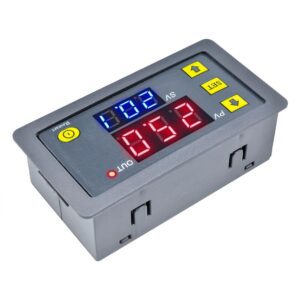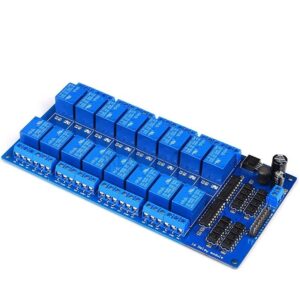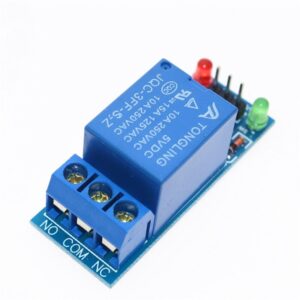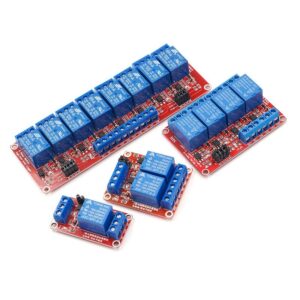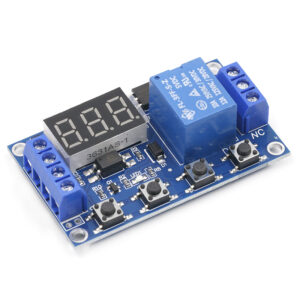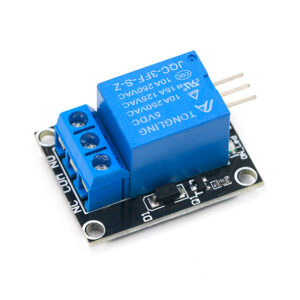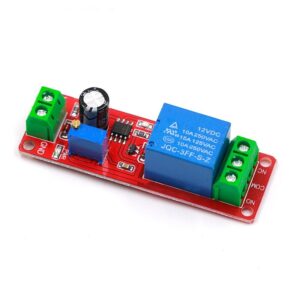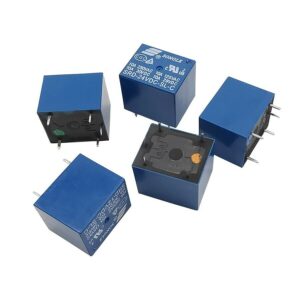Relay Modules
Our Relay Modules are designed to meet a wide range of needs and applications. We offer Relay Modules with working voltages of 5V, 12V, and 24V, ensuring compatibility with various systems. These modules not only work seamlessly with Raspberry Pi, but also with ESP32 and ESP8266, Compatible with Arduino Boards and other microcontrollers, providing you with the flexibility you need for your projects. Choose Kunkune for dependable, high-quality Relay Modules that enhance your electronic ventures.
Showing all 10 results
- £6.90 – £28.90 Select options This product has multiple variants. The options may be chosen on the product page
- £1.49 – £7.90 Select options This product has multiple variants. The options may be chosen on the product page
- £0.90 Select options This product has multiple variants. The options may be chosen on the product page
Showing all 10 results
What Are Relay Modules?
Relay modules are essential components in electronic projects that involve controlling high-voltage devices with low-voltage signals. Compatible with microcontrollers like Arduino, Raspberry Pi, and micro:bit, these modules are vital for integrating control systems in various applications, including DIY projects and industrial automation, through popular brands such as Grove, DFRobot, Waveshare, and Adafruit.
How Do Relay Modules Work?
Relay modules operate by using a small electrical signal to energize a coil, which then actuates a switch to control a larger electrical load.
When a voltage is applied to the coil of the relay, it generates a magnetic field that attracts the switch contacts, closing or opening the circuit. This mechanism allows relays to isolate the control circuit from the load circuit, preventing high-power circuits from damaging sensitive control components.
The coil resistance determines the amount of current required to energize the relay, influencing the overall efficiency of the system. By understanding the relationship between coil voltage, current, and resistance, engineers can design relay-based systems for optimal performance.
What Are the Different Types of Relay Modules?
There are various types of relay modules designed to meet different needs, including 5V, 12V, and 24V 1-2-4-8 Channel Relay Modules, the versatile 6-30V Relay Module Switch, and the timing-specific NE555 DC 12V Relay Timer, KY-019 5V 1-Channel Relay,
5V, 12V, and 24V 1-2-4-8 Channel Relay Modules
5V, 12V, and 24V 1-2-4-8 Channel Relay Modules offer flexible options for controlling multiple devices using various voltage levels in a single project.
These relay modules are a key component in electronic projects, allowing for seamless switching capabilities between different voltage ranges. The 1-2-4-8 channel configurations cater to a wide range of project requirements, from simple automation tasks to more intricate setups. Hobbyists find these modules particularly useful in designing home automation systems, smart gadgets, and interactive displays.
On the other hand, professionals rely on the reliability and precision of these relay modules for industrial automation, smart buildings, and Internet of Things (IoT) applications. The ability to operate at 5V, 12V, or 24V ensures compatibility with various power sources, making them adaptable to different environments and setups.
6-30V Relay Module Switch
The 6-30V Relay Module Switch is designed to handle a wide voltage range, making it ideal for applications requiring flexible power options.
This versatile relay module can effectively operate with voltages ranging from 6V to 30V, providing a reliable solution for various electrical setups. Its ability to adapt to different power inputs sets it apart from standard relay modules that are limited in their voltage compatibility.
One of the key advantages of the 6-30V Relay Module Switch is its versatility across different projects, whether it be home automation systems, automotive applications, or industrial machinery. Its wide voltage range allows for seamless integration into a wide array of electronic circuits, offering enhanced flexibility and compatibility.
NE555 DC 12V Relay Timer
The NE555 DC 12V Relay Timer is a precision timing module that allows for controlled switching based on specified time intervals.
Its versatile design makes it a popular choice for various applications that require precise timing functions, such as automated lighting systems, interval-based sensors, and time-delay circuits. By utilising the NE555 DC 12V Relay Timer, engineers and hobbyists can create efficient and reliable systems that operate seamlessly based on predetermined timeframes. The timer’s adjustable output pulse duration and frequency offer flexibility in customising timing parameters to suit specific project requirements, ensuring accurate and consistent performance. Its compact size and easy integration make it ideal for both small-scale projects and complex industrial applications.
What Are the Uses of Relay Modules?
Relay modules have a wide range of uses in various sectors, including temperature regulation, power switching, and home automation, rendering them essential in both DIY projects and professional settings.
Temperature Control
Relay modules are often used in temperature control systems to switch heating and cooling devices on or off based on temperature readings.
This integration is crucial in optimising the functioning of systems like smart thermostats, incubators, or industrial ovens. For instance, in a smart thermostat project, a relay module can be utilised to control the HVAC system effectively. By connecting the relay module to the thermostat, it enables the system to turn the heating or cooling unit on and off as needed, ensuring precise temperature regulation.
Power Switching
In power switching applications, relay modules are vital for controlling large loads with a small input signal, ensuring efficient and safe operation.
By acting as an intermediary between the control signal and the load, relay modules play a crucial role in various systems such as industrial machinery, home automation, and automotive applications. These modules effectively isolate the control circuit from the high power circuit, preventing damage to sensitive control components.
Relay modules offer flexibility in switching different types of loads, including resistive, inductive, or capacitive loads, allowing for versatile usage across a wide range of applications. Their ability to handle high voltage and current ratings makes them critical in managing power distribution efficiently and reliably.
Home Automation
Relay modules are essential in home automation projects, allowing devices to be controlled remotely via WiFi-enabled microcontrollers like the ESP32.
These relay modules act as the bridge between smart devices and the controlling microcontroller, enabling users to remotely turn on/off lights, fans, or any other appliances connected to the relay.
The ESP32, with its built-in WiFi capabilities, seamlessly integrates with relay modules to create a versatile home automation system. For example, users can set up schedules for lights to turn on at specific times, or even create custom triggers based on sensor inputs.
Smart home applications such as automated irrigation systems, security alarms, and garage door openers greatly benefit from the use of relay modules in conjunction with WiFi microcontrollers.
How to Choose the Right Relay Module for Your Project?
Selecting the correct relay module for your project involves taking into account several factors such as:
- voltage compatibility
- the number of channels needed
- switching speed
- any required specific timer functionality
Voltage Compatibility
Voltage compatibility is a crucial factor when selecting relay modules, ensuring they operate safely and effectively within your project’s voltage range.
Choosing the right voltage rating for relay modules is essential to prevent damage and ensure reliable performance.
First, identify the voltage requirements of your specific application to determine the appropriate relay module. Consider factors such as input and output voltage levels, as well as any potential voltage fluctuations. Check the datasheets of both the relay module and the components it will be connected to for compatibility.
It’s also important to consider any future voltage needs or expansions in your project when selecting the voltage rating. By carefully assessing these factors, you can select a relay module with the optimal voltage compatibility for your application.
Number of Channels
The number of channels in a relay module determines how many devices it can control simultaneously, making it an important consideration for complex projects.
Having the right number of channels ensures that your relay module can meet the demands of your project without any limitations. For smaller projects, a relay module with fewer channels might suffice, but for larger and more intricate setups, opting for a module with a greater number of channels is advisable.
Consider the types and number of devices you need to control within your project; this will guide you in determining the appropriate number of channels required. Factor in the scalability of your project – it’s always better to have more channels available than needed, rather than falling short and having to reconfigure your setup later on.
Switching Speed
Switching speed is a critical specification for relay modules, particularly in applications where rapid switching is required.
Relay modules with faster switching speeds can significantly enhance the performance of various systems. For example, in high-frequency signal processing applications like telecommunications and data transfer, quick relay response times are essential to ensure minimal signal distortion and latency.
When selecting relay modules based on this criterion, engineers often look for specifications that indicate the response time of the relay. Lower response times equate to faster switching speeds, which are ideal for applications where milliseconds matter.
Timer Functionality
Timer functionality in relay modules allows for precise control over the timing of switching operations, making them useful in applications that require scheduled activation or deactivation.
By incorporating timers in relay modules, users can automate processes based on specific time intervals or schedules, enhancing efficiency and convenience. For instance, in home automation projects, the timer feature can be utilised to control lighting systems at particular times, simulating occupancy for enhanced security. Industrial automation can benefit from relay modules with built-in timers, enabling sequential operations in manufacturing processes. When selecting relay modules with timers, it’s important to consider the range and accuracy of timing options, as well as the ease of programming to ensure seamless integration into projects.
How to Install a Relay Module?
Installing a relay module involves connecting it to the control circuit and the load circuit, ensuring proper wiring and safety precautions are followed.
- First, identify the control and load terminals on the relay module. The control terminals are where the voltage signal from the control circuit will be connected, while the load terminals are for the output that will control the device. Make sure correct connectors are used to secure the wires in place.
- Next, carefully inspect the wiring diagram provided by the manufacturer to ensure accurate connections. Double-check the voltage compatibility and current ratings to avoid any damage to the relay or connected devices. Remember to power off all circuits before starting the installation process.
What Are the Safety Precautions When Using Relay Modules?
When using relay modules, it is essential to follow safety precautions to prevent electrical hazards, such as ensuring proper insulation and protection against high voltage and current.
Plus insulation, another vital aspect to consider is the proper handling of voltage and current levels. It is crucial to be aware of the rated voltage and current specifications of the relay module, and to never exceed these limits to avoid overheating or electrical failure.
- Always make sure that the relay module is securely mounted or fixed in place to prevent accidental contact or movement during operation. Loose connections or inadequate fastening could lead to potential safety risks.
- Regular maintenance and inspection of relay modules are also recommended to check for any signs of wear, damage, or overheating. Any abnormalities should be addressed promptly to prevent further problems.
How to Troubleshoot Common Issues with Relay Modules?
Troubleshooting common issues with relay modules involves diagnosing problems such as non-activation, erratic behavior, and connection faults.
When tackling non-activation problems, start by checking the power source and ensuring the input signals are correctly received. Test the relay’s control signal to verify proper functioning. For erratic behavior, inspect the relay contacts for dirt or wear, as this can cause intermittent operation. Assess the load being controlled, as it might exceed the relay’s capacity.
Connection faults often stem from loose terminals or poor wiring, so tighten connections and inspect for any damaged wires. Regular maintenance is crucial, perform periodic testing of the relay module and keep it clean from dust and debris to avoid future complications.
Frequently Asked Questions
What are Relay Modules?
Relay Modules are electronic switches that allow low voltage control signals to control high voltage circuits. They are used to control various devices such as motors, lights, and appliances.
What are some common types of Relay Modules?
Kunkune.co.uk offers a variety of Relay Modules including 12V Temperature Controller, 5V,12V,24V 1-2-4-8 Channel Relay Modules, 6-30V Relay Module Switch, and NE555 DC 12V Relay Timer. These modules have different voltage requirements and channel options to suit various applications.
Are Relay Modules compatible with Arduino?
Yes, most of the Relay Modules available on kunkune.co.uk are compatible with Arduino. They can be easily integrated with Arduino boards to control high voltage devices with ease.
Explore our soldering irons, electronic testing equipment,

